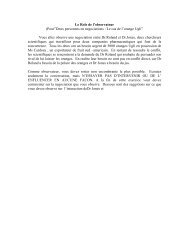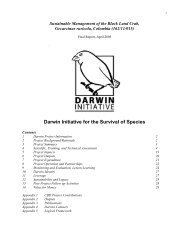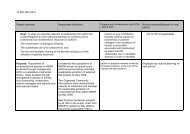Vulture Conservation Action Plan for Nepal 2008-2013 - The Darwin ...
Vulture Conservation Action Plan for Nepal 2008-2013 - The Darwin ...
Vulture Conservation Action Plan for Nepal 2008-2013 - The Darwin ...
You also want an ePaper? Increase the reach of your titles
YUMPU automatically turns print PDFs into web optimized ePapers that Google loves.
References<br />
Anderson, M.D., Piper, S.E. and Swan, G.E. (2005). Non-steroidal anti-inflammatory drug use in<br />
South Africa and possible effects on vultures. South African Journal of Science 101: 112-114<br />
Baral, H.S., Giri, J.B. and Virani, M.Z. (2004). On the decline of Oriental White-backed<br />
<strong>Vulture</strong>s Gyps bengalensis in lowland <strong>Nepal</strong>. In: Chancellor, R.D. & Meyburg, B-U. (Eds).<br />
Raptors Worldwide. WWGBP/MME pp215-219.<br />
Cuthbert, R., Parry-Jones, J., Green, R.E. and Pain, D.J. (2006). NSAIDs and scavenging birds:<br />
potential impacts beyond Asia’s critically endangered vultures. Biology Letters<br />
doi:10.1098/rsbl.2006.0554<br />
Gilbert. M., Watson, R.T., Ahmed, S., Asim, M. and Johnson, J.A. (2007). <strong>Vulture</strong> restaurants<br />
and their role in reducing diclofenac exposure in Asian vultures. Bird <strong>Conservation</strong><br />
International 17: 63-77.<br />
Green, R.E., Newton, I., Shultz, S., Cunningham, A.A., Gilbert, M., Pain, D.J., and Prakash, V. .<br />
(2004). Diclofenac poisoning as a cause of vulture population declines across the Indian<br />
subcontinent. J. Appl. Ecol. 41: 793-800.<br />
Green, R.E., Taggart. M.A., Senacha, K.R., Pain, D.J., Jhala , Y., and Cuthbert, R. (2007). Rate of<br />
decline of the oriental white-backed vulture Gyps bengalensis population in India estimated<br />
from measurements of diclofenac in carcasses of domesticated ungulates. PloS One 2(8),<br />
e686. doi:10.1371/journal.pone.0000686<br />
ILC (2003). Agricultural Statistics at a Glance 2003 and 17th Indian Livestock Census 2003,<br />
Dept. of Animal & Dairying, Ministry of Agriculture, Govt. of India<br />
ISARPW (2004). Report on the International South Asian Recovery <strong>Plan</strong> Workshop. Buceros<br />
9(1) pp 48.<br />
IUCN (2007). http://www.iucn.org<br />
Johnson J.A., Lerner H.R.L., Rasmussen P.C. and Mindell D.P. (2006). Systematics within Gyps<br />
vultures: a clade at risk. BMC Evolutionary Biology 6: 65 doi: 10.1186/1471-2148-6-65<br />
Mundy, P., Butchart, D, Ledger, J., and Piper, S. (1992). <strong>The</strong> vultures of Africa. Academic Press.<br />
Noble, S. and Balfour, J.A. (1996). Meloxicam. Drugs 51: 424-430.<br />
Oaks, J. L., M. Gilbert, M. Z. Virani, R. T. Watson, C. U. Meteyer, B. Rideout, H. L.<br />
Shivaprasad, S. Ahmed, M. J. I. Chaudhry, M. Arshad, S. Mahmood, A. Ali, and A. A. Khan.<br />
(2004). Diclofenac residues as the cause of vulture population decline in Pakistan. Nature<br />
427:630-633.<br />
Prakash, V., Pain, D.J., Cunningham, A.A., Donald, P.F., Prakash, N., Verma, A., Gargi, R.,<br />
Sivakumar, S. and Rahmani, A. R. (2003). Catastrophic collapse of Indian white-backed Gyps<br />
bengalensis and long-billed Gyps indicus vulture populations. Biological <strong>Conservation</strong><br />
109(3): 381-390.<br />
Prakash, V., Green R. E., Pain D.J., Ranade, S. P, Saravanan S., Prakash, N, Venkitachalam, R.,<br />
Cuthbert R., Rahmani A. R., Cunningham A. A. (2007) Recent changes in populations of<br />
resident Gyps vultures in India. Journal of the Bombay Natural History Society104: 129-135.<br />
Shultz, S., Baral, H.S., Charman, S., Cunningham, A.A., Das, D., Ghalsasi, D.R., Goudar, M.S.,<br />
Green, R.E., Jones, A., Nighot, P., Pain, D.J. and Prakash, V. (2004). Diclofenac poisoning is<br />
widespread in declining vulture populations across the Indian subcontinent. Proceedings of<br />
the Royal Society of London B (Supplement), 271: S458-S460.







